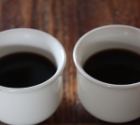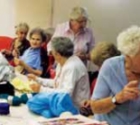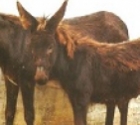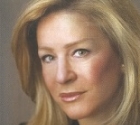
Regular readers will know about my move 'up North' and as the days unfold so do the pages of history, diversification and achievement around me. Within these pages are the people who contribute to making the Galilee a special part of the land of Israel.
Honey is synonymous with Rosh Hashanah and with that in mind I took the road to Kibbutz Shamir on the foothills of the Golan. Shamir was founded in 1948 by the first settlers, who came from Rumania. An immediate problem the settlers faced was how to turn the rocky stretches of hillside into profit bearing fields. The insistence of one of the members, whose parents had an apiary in Rumania bore fruit, and honey production became their initial occupation. They eventually had 1,800 hives with their swarms of bees supping on the wild flower and plant pollen of the surroundings to produce excellent honey. Gershon Goldstein, managing director of the present apiary, smiled as he informed me that indeed Yad Mordechai, now a well-known commercial honey producer, learnt the trade up in Shamir.
With the passing of time, testing and research into the medical and healing properties of honey and its components brought the potential market for side products to the forefront especially with the growing popularity of alternative medicines. So Kibbutz Shamir decided to invest in this aspect of production and extend its market potential. The shelves of their store boast a variety of products made from Royal Jelly: Pollenit, Propolis and Echinacea. The processes of extraction and mixing of natural ingredients is strictly quality-controlled. Research has shown that regular consumption of pollen can help with a wide number of degenerative illnesses. A new line of body products are made with a basis of honey and Propolis. Consumable products are strictly kosher and under supervision of the Ministry of Health.
On one wall of the store there is a living example of the life of the bee. There is the queen, encased in a glass covered hive; an opening to the outside world allows the workers access and egress. One can wonder over the amassed devotion of the workers and their prowess in the construction of the perfect geometric wax cells. One can view a short descriptive film on the world of the bee and grasp where the saying "busy as a bee" comes from.
By logging on to their website www.honey.co.il more details of products can be obtained. The shop is open Sundays – Fridays 09.00 – 12.00 and 12.30 – 16.00. Group visits should be pre-arranged by calling 04 694 7826.
Honey Recipes for Rosh Hashanah
Marinated Salmon:
Ingredients (for 2):
2 x 180 gm. salmon fillet steaks
1 flat dessertspoon Thai (or similar) chili sauce
Grated zest and juice of 1 small lemon
1 dessertspoon clear honey
Generous sprinkling of olive oil and black pepper
A few sprigs of coriander – chopped
Method:
Mix chili sauce, lemon, honey and ground black pepper. Pour over salmon fillets and leave to marinate for 10 – 15 minutes. Place on flat baking tray and sprinkle with olive oil. Put under hot grill and cook 2 – 3 minutes each side. They are ready when the salmon becomes opaque.
Serve sprinkled with chopped coriander.
Honey and Walnut Loaf
Ingredients:
1 cup honey
1 cup milk
½ cup sugar
2 ½ cups whole-wheat flour
1 teaspoon soda
1 teaspoon salt
½ cup walnuts; chopped
¼ cup butter
2 egg yolks
Method:
Makes 9 x 5-inch loaf. Combine honey, milk and sugar in 3-quart saucepan. Heat over medium heat, stirring constantly, until sugar is dissolved. (Mixture will be lukewarm.) Cool. Sift together flour, soda and salt. Add the dry ingredients, walnuts, butter and egg yolks to the honey-milk mixture; mix thoroughly. Turn into 9 x 5 x 3-inch pan, well greased on the bottom. Bake at 160 degrees for 1 1/4 to 1 1/2 hours. Cool before slicing.
Givat Oren.
Heading north on Route 90, one makes a left turn at the Machanaim traffic lights; about 200 meters after the turn a sign to your right states Givat Oren Winery; turn and make your way along the narrow road to the parking lot beside the winery. Around and in front of you is a myriad of fruit and olive trees; enter the gate passing a slab of stone on which is inscribed in Hebrew letters: Givat Oren – a garden in memory of Zahava and Zvi Oren. Thereby hangs a tale, a tale of sorrow and devotion, a tale of a family that began with the founding of Rosh Pina in 1882 and is honored by the produce of this 60 dunam green and flowering piece of land.
Promptly at 09.00, Ruth Meister, slim, energetic and enthusiastic, greeted us at the gates as arranged. Introductions over, we began to walk up towards a large pergola which sheltered wooden tables and chairs. "Every season there is a fruit to taste." She stopped beside a canopy formed from luxuriant vines trained over and spreading out from the trunk and branches of a large tree, from which hung luscious green grapes. "Here try these - a taste of days gone by," she explained, stretching up to pick some for us to sample. We continued on our way and reaching the pergola negotiating a carpet of red cherries spread out on plastic sheeting under three large, electric fans. "We dry the second rate cherries – they can be used for so many things." Ruth continued as we sat down in the shade and surveyed the botanical richness around us.
"Imagine this was just rocks and thorns sixteen years ago – it was all Yacov's endeavors." Ruth began to narrate the history of their families and disclose the reason for this obvious labor of love and the secret of the enchanted hillock.
Yacov's family was amongst the early Jewish families in Safed – his great-grandfather, Alter Schwartz, left there for Gai Oni, the first settlement formed in the area of today's Rosh Pina in1878; there he built a small hotel but severe drought forced the settlers to abandon the area. It was in 1882 that Ruth's great grandfather, David Bukchester, came from Rumania, one of the group that founded Rosh Pina in that same area. He was an expert in farming – a rare find amongst the First Aliyah. Over the years the Bukchesters managed to officially purchase 400 dunams of land and multiply, en route hebraicising their name to Oren.
In 1991 Ruth's parents were discovered murdered in their home, a still unsolved mystery. Grief and shock remained with the family and so Yacov decided to form something special in their memory. At that time he was in management with Bank HaPoalim but gave every spare moment to cultivating and bringing this stretch of land to fruition. As the work progressed, ideas flowed. A small hilly area disclosed ancient wine presses in the rocky ground they cleared and the determination to produce wine from this land once more came into being. To this end, Yacov attended a course in wine-making at Tel Chai College. During this time a small cave that had been used by the Sudanese laborers who worked for the family a hundred years before was uncovered and this gave birth to the idea for the construction of a further, larger cavern in which the wines would be brewed and stored. Today the cave is home not only to vats of wine and presses for their olive oil but to a spacious and interesting area for tasting and relaxing in an atmosphere enriched with the odors of their produce.
There are a few more tales to be told but that is up to Ruthie to tell when you visit. She can be contacted on 04 693 5345 or 054 497 6940. There are new wines in the vats and olive oil at its purest plus some unforgettable views of the Hula valley and surrounding hills.
"Oforia" – Israel's first reserve of the Nature and Parks Authority.
Just north of the Dubrovin Farm and down a narrow road shaded by thick masses of foliage spreading overhead from mature trees, one reaches this reserve. Small and less impressive to the eye than the second and much newer Hula Reserve, this spot revives the past and returns us to how the land was before the onset of drainage and cultivation. Begin the visit in the Visitors’ Center where an exhibition documents the history of the Hula Valley. One is introduced to the many species for which the Reserve is now home and then treated to a three dimensional audio-visual show with all necessary effects thrown in.
Then a walk along a two kilometer nature trail shares the history, the plants and the wild life with the visitor. Seasonal changes are obvious – summer being one of the best times to view the richness of the flora and meet with some of the fauna. Autumn introduces the flocks of European birds, numerous on their flight routes to Africa – some 470 different species. In winter, nature's colors fade and fallen leaves form thick carpets – in many ways a deadened landscape brought to life by the presence of some of the birds who stay over and will breed in the spring. And then spring brings forth its colors which it shares with the plumage of the birds as they once again land for rest and food on their journeys to Europe. It is all there – water, swamp and meadow land with water buffalo, nutria and turtles; in the waters swim catfish and from the soil bloom wild flowers that change by the season.
As the Reserve hosts many groups of young visitors it is advisable to enquire about the best times for visiting by phone prior to arriving. The film is available with an English sound-track – this also by prior arrangement.
Visiting hours
Sunday – Thursday 08.00 – 17.00 – last entrance 16.00
Fridays and holiday eves 08.00 – 15.00 – last entrance 14.00
Guided tours for groups may be arranged in advance.
Enjoy the Galilee.
 News for Modi'in
News for Modi'in Esra Aid to the Blind Coffee Morning
Esra Aid to the Blind Coffee Morning Netanya News
Netanya News A new website in English - on Volunteering - Launched in Israel
A new website in English - on Volunteering - Launched in Israel Help Needed for Abused Horses and Donkeys
Help Needed for Abused Horses and Donkeys Heather's Heseg
Heather's Heseg Barbara Abraham
Barbara Abraham